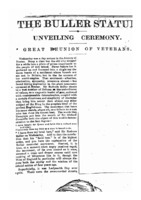How to cite this page Comment citer cette page
Items
In item set
Documents
-
2020, Critical social media posts about the monument to Gallieni in Paris Following the murder of George Floyd by a police officer in the United States, antiracist protests inspired by Black Lives Matter flourished in France in the Spring of 2020. On June 10, the popular content creator behind Histoires Crêpues, a YouTube channel, Instagram and Twitter account, shared a 4 minutes Instagram video in front of Gallieni's statue. He reposted various versions of it on Twitter and YouTube in the following days. He mentioned that on June 7, antiracist protesters took down the statue of Edward Colston, and pointed out that in France also, the streets were full of homages to colonizers and slave traders. He gave historical context on Gallieni's colonial career, his invading the then called French Sudan, in Tonkin (Vietnam), and sent to quash resisting forces in Madagascar. He linked sources to Gallieni's writings, including a passage of Gallieni's Rapport d'ensemble sur la pacification, l'organisation et la colonisation de Madagascar, where Gallieni talks about "la politique des races", a military occupation strategy where France would pit Madagascar's different ethnicities against one another, focusing on destroying the ethnic group that was the most hostile to French colonialism. The content creator argued that Gallieni was in that sense relying on Arthur de Gobineau's racist theories. While racist ideologies underpinned the entire French colonial project, with the idea that France was superior to the populations it invaded and submitted to its rule, Gallieni's doctrine required to study local power dynamics and the cultural specificities of each ethnic group to France's advantage. He asked why Gallieni had so much presence in French public space, citing a métro station, and the avenue Gallieni in Paris, a prestigious street that connects the Seine to the Invalides building, deploring that it was dedicated to the colonial hero who designed "la politique des races". He deplored that not knowing this history was making it more difficult to combat racism in contemporary France. (From the video: "elle est consacrée au héros colonial concepteur de la politique des races. C'est à peine croyable, comment peut-on espérer lutter contre lutter contre le racisme en France quand personne ne connaît cette histoire ?") He then goes around the monument and describes its component, insisting on the allegories of the pedestal, point out that they are "clichés" linked to Gallieni's colonial career and that the Africa woman is bare-chested. He also points out that the monument was commissioned by the Ligue Maritime et Coloniale Française, reading the inscription on the plinth. "Ce sont ces quatre personnages qui représentent les peuples qui ont été colonisés par Gallieni et qui le portent. Franchement, c'est extrême. Franchement, je sais pas, en tant qu'afrodescendant, tu te balades dans la rue, et tu vois ce genre de monuments en l'honneur d'un héros colonial, ça fait mal en fait, c'est... franchement, je sais même pas quoi dire." He ends this video asking whether these public homages are still necessary, or if more context would be needed to fully understand the history alluded to by the monument, suggesting that it might be better to place it in a museum. Finally, he asked municipal and state power what the message was to the population, by keeping these colonial monuments without explanation, and urged for more education about history of French colonialism and slavery to combat racism today. "Est-ce que nous avons vraiment besoin de tous ces hommages coloniaux ? Ne seraient-ils pas mieux dans des musées qui pourraient clairement nous expliquer cette histoire ? Je m'adresse directement à la mairie du 7e arrondissement de Paris, au Ministère de la Culture, et à Emmanuel Macron, président de la République française. Je demande : quel est le message que vous voulez nous faire passer en conservant ces hommages coloniaux sans nous donner aucun contexte historique pour mieux les comprendre ? On veut des réponses. Je crois que continuer à creuser notre histoire coloniale c'est un bon moyen de lutter contre le racisme tel qu'il existe aujourd'hui dans notre pays la France. Un racisme directement lié à notre histoire coloniale et notre passé esclavagiste français." In the following days, comments and reposts on social media engage with the contents of the video about the monument, both critical of Gallieni, and critical of Histoires Crêpues.
-
2017, Déclaration du député de Fort-de-France Serge Letchimy "Le député Serge Letchimy condamne l’enlèvement du buste du Mahatma Ghandi de son socle, ce week-end, et rappelle que ce buste placé à la Croix-Mission, non loin du quartier Obero, a été offert par le gouvernement indien en 2003, année de la Commémoration du cent-cinquantenaire de l’arrivée des premiers travailleurs indiens en Martinique. Un tel acte de vandalisme est inacceptable et irrespectueux vis à vis de la communauté indienne de la Martinique, ainsi que pour tous ceux qui reconnaissent chez Gandhi le représentant de la lutte non violente contre le colonialisme. »
-
 Maroon Memorial, Sainte-Anne. Photography: Cannelle Boisdur
Maroon Memorial, Sainte-Anne. Photography: Cannelle Boisdur -
 Monument to général Faidherbe, Lille, 1920 Postcard. Archives municipales de Lille, 7Fi/721
Monument to général Faidherbe, Lille, 1920 Postcard. Archives municipales de Lille, 7Fi/721 -
 Monument to general Faidherbe, 1910 postcard. Lille municipal archives, 7Fi/244/7
Monument to general Faidherbe, 1910 postcard. Lille municipal archives, 7Fi/244/7 -
 Le monument au général Faidherbe lors de son classement Monument historique en 1975. Archives municipales de Lille, 1M/2/57. The monument to General Faidherbe when it was classified as a historic monument in 1975. Archives municipales de Lille, 1M/2/57.
Le monument au général Faidherbe lors de son classement Monument historique en 1975. Archives municipales de Lille, 1M/2/57. The monument to General Faidherbe when it was classified as a historic monument in 1975. Archives municipales de Lille, 1M/2/57. -
 2017, Plaques from the "Identity" project in front of the monument to General Faidherbe. Photography : Thomas Deltombe
2017, Plaques from the "Identity" project in front of the monument to General Faidherbe. Photography : Thomas Deltombe -
 Maroon Memorial, Sainte-Anne. Photography: Cannelle Boisdur.
Maroon Memorial, Sainte-Anne. Photography: Cannelle Boisdur. -
 Mémorial du Nèg Mawon, Sainte-Anne, de face. Photographie : Cannelle Boisdur.
Mémorial du Nèg Mawon, Sainte-Anne, de face. Photographie : Cannelle Boisdur. -
 The roundabout to which the Maroon Memorial has been moved. Photography: Cannelle Boisdur.
The roundabout to which the Maroon Memorial has been moved. Photography: Cannelle Boisdur. -
 "Maroon" photo challenge, Collectif Moun Gwadloup Facebook page, November 30, 2020, reproduced with their kind permission.
"Maroon" photo challenge, Collectif Moun Gwadloup Facebook page, November 30, 2020, reproduced with their kind permission. -
2017, "What to do with the statues of French slaveholders" Article du journaliste Vincent Manilève dans le contexte du retrait aux Etats-Unis de la statue du général confédéré Robert E. Lee
-
2020, Article on "statues that hurt the eye" like Germain Cet article fait le lien avec la mobilisation pour George Floyd et les déboulonnages de statues. Sont mentionnées les statues de Jacques Chirac et de François Hollande, tous deux élus de Corrèze, inaugurées en septembre 2020, le monument Germain et les statues de Bugeaud.
-
 1905, Official Souvenir of the Unveiling of the Buller Memorial Fourteen page illustrated official souvenir booklet for the unveiling of the statue of Redvers Buller in Exeter on September 6 1905. The author is anonymously given as "Oaken". The official souvenir details Buller's career in the British Army, his medals, a biography of the sculptor Captain Adrian Jones, the story of the Buller statue campaign, and the order for the day's events.
1905, Official Souvenir of the Unveiling of the Buller Memorial Fourteen page illustrated official souvenir booklet for the unveiling of the statue of Redvers Buller in Exeter on September 6 1905. The author is anonymously given as "Oaken". The official souvenir details Buller's career in the British Army, his medals, a biography of the sculptor Captain Adrian Jones, the story of the Buller statue campaign, and the order for the day's events. -
 1905, Exeter Flying Post article on the Redvers Buller statue
1905, Exeter Flying Post article on the Redvers Buller statue -
1920, H. J. Wilkins, Edward Colston [1636-1721 A.D.]: A chronological account of his life and work together with an account of the Colston Societies and memorials in Bristol Written by the Reverend Henry John Wilkins in 1920, this biography was the first to explicitly identify Colston's involvement in the transatlantic slave-trade and the Royal African Company.
-
 1983, National Heritage Act
1983, National Heritage Act -
 1990, Planning (Listed Buildings and Conservation Areas) Act The key legislation that currently (in 2024) applies to the management of listed statues in the UK
1990, Planning (Listed Buildings and Conservation Areas) Act The key legislation that currently (in 2024) applies to the management of listed statues in the UK -
 2002, Stroud Town Council Finance and Policy Committee Agenda
2002, Stroud Town Council Finance and Policy Committee Agenda -
 2002, Stroud Town Council Finance and Policy Committee Minutes
2002, Stroud Town Council Finance and Policy Committee Minutes -
 2002, Stroud Town Council Minutes
2002, Stroud Town Council Minutes -
 2003, Stroud Town Council Planning Committee Agenda
2003, Stroud Town Council Planning Committee Agenda
-
 2004, Stroud Town Council Planning Committee Minutes
2004, Stroud Town Council Planning Committee Minutes -
 2017, Faidherbe statue falls in Saint-Louis. Photograph by Thierno Dicko.
2017, Faidherbe statue falls in Saint-Louis. Photograph by Thierno Dicko. -
 Extract from the Open Letter to Martine Aubry, sent in May 2018 by the Faidherbe doit tomber collective. Credit: Faidherbe doit tomber.
Extract from the Open Letter to Martine Aubry, sent in May 2018 by the Faidherbe doit tomber collective. Credit: Faidherbe doit tomber. -
 2020, "stop colonialism" collage on the pedestal of the monument to General Faidherbe. Photography: anonymous colleuse
2020, "stop colonialism" collage on the pedestal of the monument to General Faidherbe. Photography: anonymous colleuse -
 2020, banner in front of the monument to General Faidherbe. Photography: Lille insurgée.
2020, banner in front of the monument to General Faidherbe. Photography: Lille insurgée. -
 Statue of Voltaire: a site combining protection and visibility of the work under study Press release from the City of Paris
Statue of Voltaire: a site combining protection and visibility of the work under study Press release from the City of Paris -
 2021, Task and Finish Group, The Slave Trade and the British Empire - An Audit of Commemoration in Wales In July 2020 the First Minister of Wales appointed a Task and Finish Group to audit public monuments, street and building names in Wales associated with the slave trade and the British Empire and also touching on the historical contributions to Welsh life of people of Black heritage. The Task and Finish group was made up of Gaynor Legall (Chair), Dr Roiyah Saltus, Professor Robert Moore, David Anderson, Dr Marian Gwyn, Naomi Alleyne, Professor Olivette Otele and Professor Chris Evans. Supporting research and drafting was undertaken on behalf of the group by Dr Peter Wakelin.
2021, Task and Finish Group, The Slave Trade and the British Empire - An Audit of Commemoration in Wales In July 2020 the First Minister of Wales appointed a Task and Finish Group to audit public monuments, street and building names in Wales associated with the slave trade and the British Empire and also touching on the historical contributions to Welsh life of people of Black heritage. The Task and Finish group was made up of Gaynor Legall (Chair), Dr Roiyah Saltus, Professor Robert Moore, David Anderson, Dr Marian Gwyn, Naomi Alleyne, Professor Olivette Otele and Professor Chris Evans. Supporting research and drafting was undertaken on behalf of the group by Dr Peter Wakelin. -
 Stephen Mullen, 'Glasgow, Slavery and Atlantic Commerce: an Audit of Historic Connections and Modern Legacies', (Report for Glasgow City Council, 2022)
Stephen Mullen, 'Glasgow, Slavery and Atlantic Commerce: an Audit of Historic Connections and Modern Legacies', (Report for Glasgow City Council, 2022) -
 Affiche "Cycle moi l'histoire" sur l'exposition coloniale de 1931 d'Alter Natives
Affiche "Cycle moi l'histoire" sur l'exposition coloniale de 1931 d'Alter Natives -
 2022, The Colston Statue: What Next? ‘We are Bristol’ History Commission Full Report Following a survey conducted by Bristol City Council in June-October 2021 regarding the opinions of local people on the future of the Colston statue, We Are Bristol History Commission issues its report with recommendations.
2022, The Colston Statue: What Next? ‘We are Bristol’ History Commission Full Report Following a survey conducted by Bristol City Council in June-October 2021 regarding the opinions of local people on the future of the Colston statue, We Are Bristol History Commission issues its report with recommendations. -
 2023, Pupitre installé par la mairie de Lille et autocollants Faidherbe doit tomber. Photographie : Collectif Faidherbe doit tomber
2023, Pupitre installé par la mairie de Lille et autocollants Faidherbe doit tomber. Photographie : Collectif Faidherbe doit tomber -
 2023, Relocation of the statue of Mahé de la Bourdonnais. Photography : Loran Hoarau
2023, Relocation of the statue of Mahé de la Bourdonnais. Photography : Loran Hoarau -
 2023, Moving the statue of Mahé de la Bourdonnais - crane. Photography : Loran Hoarau
2023, Moving the statue of Mahé de la Bourdonnais - crane. Photography : Loran Hoarau -
 2024, Dr Stephen Mullen, Dr Andrew Mackillop and Stephen Driscoll, Surveying and Analysing Connections between Properties in Care and the British Empire, c.1600–1997
2024, Dr Stephen Mullen, Dr Andrew Mackillop and Stephen Driscoll, Surveying and Analysing Connections between Properties in Care and the British Empire, c.1600–1997 -
 The statue of Voltaire is back in Paris Press release from the City of Paris
The statue of Voltaire is back in Paris Press release from the City of Paris